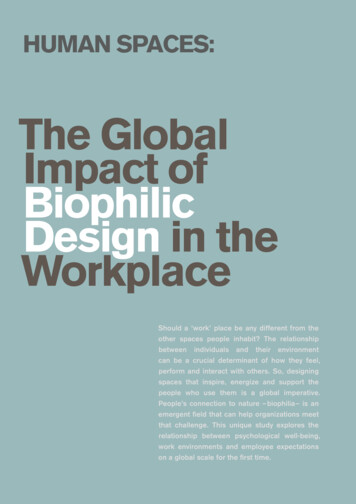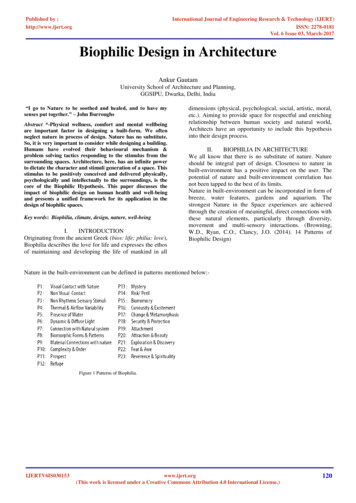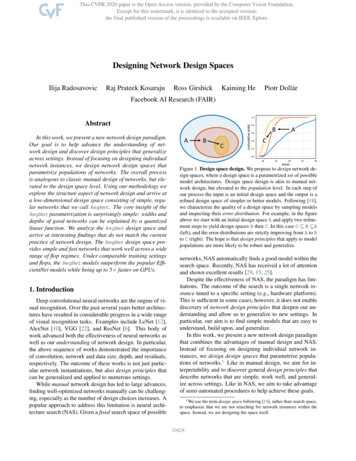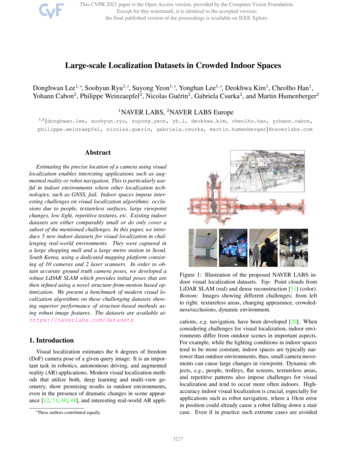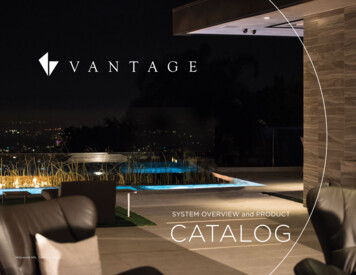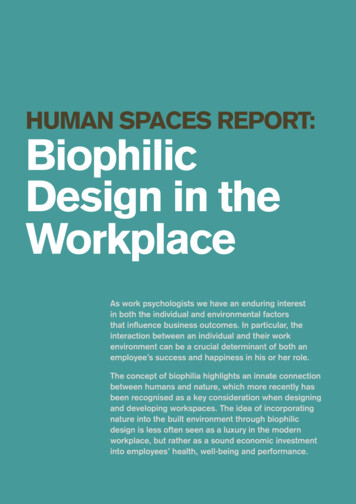
Transcription
HUMAN SPACES REPORT:BiophilicDesign in theWorkplaceAs work psychologists we have an enduring interestin both the individual and environmental factorsthat influence business outcomes. In particular, theinteraction between an individual and their workenvironment can be a crucial determinant of both anemployee’s success and happiness in his or her role.The concept of biophilia highlights an innate connectionbetween humans and nature, which more recently hasbeen recognised as a key consideration when designingand developing workspaces. The idea of incorporatingnature into the built environment through biophilicdesign is less often seen as a luxury in the modernworkplace, but rather as a sound economic investmentinto employees’ health, well-being and performance.
A message fromProfessor Sir Cary CooperThe work environment has always been recognised as essential toemployee well-being and performance but often purely as a ‘hygienefactor’ – an element which can only have a negative impact iforganisations get it wrong. It’s no coincidence that the most modernemployers now take a different view, designing environments to helppeople thrive, collaborate and be creative. Being connected to natureand the outside world is a big part of that, and research is struggling tokeep pace with the best practice that organisations are adopting to makethat connection happen at work. This new research report is an importantand practical piece, summarising existing research on the differentapproaches to biophilic design and their impact, and building on it witha new study of real employee perspectives on what inspires them in theirwork environments across EMEA countries.3 HUMAN SPACES REPORT: Biophilic Design in the Workplace
Design inthe workplace– the biophiliaimperative
Design in the workplace –the biophilia imperativeWhat makes work feel good? For modernorganisations and their people, it’s about much morethan the end goal of productivity and profit. How wegain meaning, a sense of well-being and of purposein the workplace is just as vital, not only to feel goodbut to perform effectively too. Increasingly, employersand employees themselves are engaging in thisdebate about a more comprehensive view of workand the role it plays in our lives, as are governmentsand societies with the growth of projects measuringnational well-being across the world. A connectionwith the natural world is a big part of that discussionhowever we frame it – escaping the concrete jungle,achieving a better level of balance or simply being ina space that is enjoyable.5 The increasing academic and organisationalinterest in biophilia and biophilic design is drivenby the positive outcomes that it can help createfor individuals and businesses, many of which arediscussed at length in this report. The timing behindthis burgeoning interest lies in the wider sociohistorical context of a major movement of populationsglobally into urban areas – we are as disconnectedfrom nature as we have ever been. Figures show1 aremarkable shift during the 60 years between 1950and 2010 with some countries seeing over 40% oftheir population residing in urban areas comparedwith non-urban areas. In France that figure is 22.6%,in the Netherlands, 26.8%, in the United ArabEmirates, 22.4%, in Switzerland a massive 32.7%and in Turkey, an even greater 44.8%.HUMAN SPACES REPORT: Biophilic Design in the Workplace
Design in the workplace –the biophilia imperativeIncreases in percentage of population living in urban areas in EMEA countriesPercentage inurban areas (2010)Percentage inurban areas (1950)PercentageincreaseCentral African .335.5Czech 9.624.844.8Ukraine68.935.533.4United Arab Emirates76.954.522.4United Kingdom90.179.011.1Country6 HUMAN SPACES REPORT: Biophilic Design in the Workplace
Design in the workplace –the biophilia imperativeAt a time when organisations have more knowledgethan ever before about the effect of workenvironments on their people – physically,psychologically and socially – it’s perhaps surprisingthat the biophilia agenda is still in its nascent form.Despite the number of clinical studies in existence onthe impact of biophilia on a range of humanbehaviours, there are relatively few studies conductedoutside the lab linking the field with organisationalpsychology. With this review and the new researchcontained within it, the aim is to kick-start thediscussion within organisations about workspacedesign and its role in organisational well-being,performance and culture, as well as the possibilitiesthat biophilic design can create.,A background to biophiliaThe ‘Biophilia Hypothesis’ 2 suggests thatthere is an instinctive bond between humanbeings and other living systems. It literallymeans a love of nature, and suggests aningrained affinity between humans and thenatural world. Therefore, biophilic design isa response to this human need and worksto re-establish this contact with nature inthe built environment3. Ultimately, biophilicdesign is the theory, science and practiceof bringing buildings to life and aims tocontinue the individual’s connection withnature in the environments that we live andwork in everyday 4.In today’s contemporary built environment,people are increasingly isolated from thebeneficial experience of natural systems andprocesses4. Yet it is often natural settingsthat people find particularly appealing andaesthetically pleasing. So by mimicking thesenatural environments within the workplace,we can create workspaces that are imbuedwith positive emotional experiences. It isoften the case that we don’t take enoughtime to immerse ourselves in nature, orappreciate the living systems that existeverywhere around us, making it vital forus to incorporate nature into our day-to-dayenvironments.7 HUMAN SPACES REPORT: Biophilic Design in the Workplace
Uniqueresearchinto biophilicdesign
Unique researchinto biophilic designLed by Professor Sir Cary Cooper, Robertson Cooperhas studied the impact of work environments forthe past 15 years, collecting a significant weight ofresearch and real data from within organisations thatlinks job conditions to performance and well-being.Just as management styles and workloads determinepeople’s experience at work, so can their physicalsurroundings. For businesses looking to perfect thatexperience, biophilia is increasingly a clear area offocus and investment.Although these benefits have all beencomprehensively proven in isolated studies, thereare few if any cross-country studies that examinethe preferences of individual employees in terms ofbiophilic design and the impact of meeting thosepreferences. Building on Robertson Cooper’sexpertise in workplace psychology, this new researchstudy examines real perspectives from real people,making tangible links between natural elements in theworkplace and the way they make us feel.Existing research into the impact of biophilia inthe workplace demonstrates tangible benefits forindividuals and their organisations. Contact withnature and design elements which mimic naturalmaterials have been shown to positively impacthealth, job performance and concentration, andto reduce anxiety and stress. In turn, there areproven links between work environmentsexhibiting biophilic design and lower staffturnover and sickness absence rates.The new study is also significant in surveyingemployees from across Europe, Middle East andAfrica (EMEA). Collecting responses from the UK,United Arab Emirates (UAE), France, Germany, theNetherlands, Spain, Sweden and Denmark, theresearch quantifies the benefits of biophilic design,specifically for well-being and productivity, and alsoprovides a practical introduction to how to achievethose benefits. In doing so, the study adds to theexisting evidence base and provides a blueprint fornatural, high performing organisations.Sample Demographics 3600 employees from eight countries (UK, France, Germany, Netherlands, Spain, Sweden,Denmark and UAE) 52% of the sample were female Largest proportion of respondents worked for the government or in public services (23%) Most respondents worked in either a town (32%) or a city centre (31%) Largest proportion of respondents fell in the age bracket of 35-44 (30%) Largest proportion of respondents spent 30-39 hours a week at work (38%)9 HUMAN SPACES REPORT: Biophilic Design in the Workplace
Unique researchinto biophilic designHeadline EMEA stats 30% of EMEA office workers said their workspace does not provide a sense of light and space A third (33%) of respondents reported they do not have a quiet space to work in when at the office 40% of EMEA office workers said they felt most productive at work at their own desk in a solitaryoffice 31% of respondents said they felt most productive at work at their own desk in a open plan office Over two thirds (67%) of respondents said the design of a company’s office would not affect theirdecision to work there but researchers suggest that there is a subconscious draw towards naturalenvironments Sustainable (30%) and minimalist (29%) were the building designs EMEA office workers reportedto inspire them the most 7% of respondents had no window view in their workspace White and grey were the most commonly used office colours Only 45% of EMEA office workers had live plants in the officeComment from Cary:We can see here a general deficiency in the provision of nature contact inthe workplace with many EMEA office workers going without what we canconsider the basics such as windows and natural light. This is concerningin the modern work environment where the employee’s workspace isrecognised as essential to their well-being and performance. In theexisting literature we can see the positive impact that natural elementscan have on individuals and so here we intend to summarise thisresearch and combine it with real employee insights into how theseconnections are presented in the workplace.10 HUMAN SPACES REPORT: Biophilic Design in the Workplace
Unique researchinto biophilic designIntegrating Nature into the WorkplaceWe know there is an instinctive bond betweenhuman beings and other living systems, so how doesintegrating nature into the workplace lead to positiveorganisational, psychological and physical healthbenefits? Biophilic design brings offices to life, andgoes far beyond the practical benefits of a singleplant recycling air behind the reception desk of ahigh-rise building.Much research into biophilia supports the positiveimpact that this nature contact can have. Studieshave shown the diversity of that impact includesincreasing a customer’s willingness to spendmore in a retail environment, increasing academicperformance amongst school children and evenreducing anxiety and stress before medicalprocedures.11 In the workplace we are concerned with biophilicdesign in relation to employee outcomes, specificallyin the areas of well-being, productivity and creativity.Our cross-country findings show that naturalelements in the workplace are determinants ofthese three aspects. The research has shown thatoverall, those with natural elements present in theirworkspace report higher levels of creativity, motivationand well-being. The findings can be integrated toprovide practical insights into modern workspacedesign, for example internal green space and naturallight are positively linked to greater productivity andthose with live plants in the office reported higherlevels of well-being than those without. Thesefindings are reflected by the top five elements thatEMEA office workers reported as desired additions totheir workspace.HUMAN SPACES REPORT: Biophilic Design in the Workplace
42%of employeeshave no natural lightUnique research55%into biophilic designof employees don't haveaccess to any greenery7%NEW RESEARCH FINDINGSof employeeshave no windowsTop 5 elements mostwanted in the office spacet (4 2 %)h t c ol o uretw o r ki nsp%)8 %)A v i e w ofe s e a (20inthd o o r pl a)s (1%nta c e (22(1 5QuigigsBrghN a t u r a l li%Li v)eWhat inspires happiness,creativity and productivityin the workplaceIncorporating natural elements into the builtTo examine this existing evidence base in detail,‘Sustainable’ (30%) was most often cited as the styleof building design that would inspire at workHsenvironment not only reflects the aesthetic benefitsand to supplement it with our own new research,of the outside world, it provides a rich environmentthe paper will split into sections, each focussinginespSpain: Green spacepfor individuals that encourages interaction.Existingon one of three key business outcomes that canaSweden:beAvoidinggreyresearch on biophilia shows that people exposedleveragedwith biophilic design; well-being,workenvironmentsto natural elements are more energised by theirproductivity and creativity. In addition, we will drawsurroundings, feel less stressed and have improved UK: Uselinkswith elementsof naturalwood, of organisational psychology5attention spans . Recently, white papers such asbehaviourstone andandwhiteshadesthat can help organisations to place‘The Economics of Biophilia’5 have demonstrated UAE: Viewsbiophilicdesign within their wider strategies forof closed water,that using natural materials and evoking nature withinsuch as lakespeople and performance.a workspace are not extravagances, but a way toFrance: Views of waterincrease profits and make hard cost-savings.and nature12 Netherlands: Green spacesand views of treesHUMAN SPACES REPORT: Biophilic Design in the WorkplaceDenmark: Indoor andoutdoor green space
Theimpact ofbiophilia
The impactof biophilia1. Biophilia and the well-being advantageThe great management theorist Maslow wasexamining the aesthetics of the workplace, and theirimpact, as long ago as the 1950s. His studies foundthat the quality of office design influenced officeworkers, with aesthetically pleasing spaces havinga positive impact on energy levels and well-being6.Further to this, research shows that the presenceof natural elements indoors can evoke the samebenefits as the outdoor environment7, supporting thecase for biophilic office design.NEW RESEARCH FINDINGSEMEA office workers who work inenvironments with natural elements,such as greenery and sunlight,report a13%mute colours (brown and grey specifically) wereassociated with greater reported levels of stress.In contrast, employees in offices with bright accentcolours (red, yellow, purple, orange, green andblue) reported lower levels of stress. Ultimately it isimportant for organisations to recognise the particularcolours that have the best impact in terms ofemployee well-being and consider how these colourscan reflect the natural elements that inspire us.The restorative effects of natureWhen EMEA office workers’ attention isfocused on demanding tasks, disruptiveenvironmental factors may lead to mentalfatigue, whereas environments that providea possibility for more effortless attention,such as one with natural elements, offer anopportunity to restore mental capacity. Thesesurroundings, dominated by elements ofnature, are thought to be restorative10.higher levelof well-beingIn the work environment, the benefits of nature havealso been recognised, with research in Norwayfinding that natural elements within an office space,such as plants, can prevent fatigue when completingtasks that demand high concentration or attention11.Across Europe, research has shown that the simplepresence of natural elements in the work environmentcan act as a buffer against the negative impact of jobstress and positively impact general well-being8. It’sa connection which has been made in many settings,including the healthcare profession. For example, inpatient waiting rooms with murals depicting naturalscenes such as mountains, sunset, grassy areasand stone paths patients felt significantly calmer andless tense than those sat in a waiting room with plainwhite walls9. In the work environment our researchpresents similar findings, showing that the use ofSimilarly, we found that across countries, thepresence of natural elements was consistentlyassociated with higher reported levels of happinessat work, in comparison to work environments voidof nature. Further to this, employees working inoffices with both internal and external green spacesalong with plenty of natural light reported higherlevels of well-being, in comparison to those workingin environments without these natural features. Ourstudy reported levels of well-being and productivitythat were 13% and 8% higher, respectively, for those14 HUMAN SPACES REPORT: Biophilic Design in the Workplace
The impactof biophiliaEMEA office workers in environments containingnatural elements. However, despite the benefits thatnatural light and space can provide, it was found that30% of workers do not work in environments thatprovide this sense of light and space. Findings suchas this should urge organisations and designers toconsider how existing and future workspaces can bebuilt or modified to provide light and space and in turnincrease levels of well-being and productivity withinthe workforce.Other studies have suggested that such naturalelements do not necessarily have to be “real”.Research has shown the positive effects of even animage of greenery over other aspects of the obviousworkspace such as walls, furniture and flooring canalso have positive benefits if elements of the outdoorenvironment are effectively re-created indoors12.Natural elements positively linked towell-being at work: UK: Light, wood and stone materials France: Views of nature and open water Netherlands: Views of trees Denmark: Natural light and green space UAE: Views of water such as the ocean,lakes or ponds Sweden: Natural light had a positiveimpact on levels of happiness at work.However, the use of grey colours wassignificantly linked to greater levels ofstress in the office15 These findings show that there are specific designelements linked to workplace well-being whichprovide organisations with another lever to pull tocreate a positive work environment. The recentupward trend in so-called ‘presenteeism’ – thetendency of employees to report to work, but be lessfocused due to low well-being or disengagement withtheir role – presents employers with an imperative toconsider biophilic design as an option which canboost well-being and provide areas in the workspacefor respite and renewal.Presenteeism is a relatively new area of study.Global figures to estimate its cost to employers donot yet exist, but figures from the UK suggest thescale of the issue, costing businesses 1 billion ayear according to the significant Foresight study intomental capital and well-being13. This cost is estimatedat 1.3 times that of absenteeism, a clear indicator ofthe benefit for businesses who can tackle the issuethrough a range of measures, including workplacedesign.A concept related to presenteeism and engagementin a job role is that of employee perceptions.Specifically, an employee’s perception of howvalued and supported they are by their employercan be a key determinant of well-being at work.This perception is accounted for in many validatedpsychological tools that seek to measure well-beingin the workplace and it represents a possible inherentbenefit of biophilic design - that the act of providinga purpose-designed environment for employees canboost those perceptions of value and support and inturn impact well-being.Given the economic imperative for organisations toprovide positive work environments, and the wealthof academic evidence that shows the impact ofbiophilia, surprising percentages of EMEA officeworkers still have no natural light (42%), greeneryHUMAN SPACES REPORT: Biophilic Design in the Workplace
Human Spaces ReportTheimpactBiophilic Designthe Workplaceof inbiophilia(55%) or window view (7%) within their environment.Such findings highlight a relatively simple opportunityto improve workspaces and increase well-being. Ourresearch suggests that the simple incorporation ofnatural elements into the workplace can substantiallyimpact employees’ reported well-being in apositive way. For organisations, this represents anofficeworkers are nowopportunity ofto EMEAintegratea considerationof the naturalbased in either a town or a city centreenvironment and the provision of ‘green’ spaceswith other initiatives that form part of their healthEMEAoffice workerswho workinand well-beingstrategies.This could,for example,environmentswithnaturalelements,mean linking biophilic design with health and fitnesssuch as greenery and sunlight,programmes at work or with simply encouraging moremovement for those in predominantly sedentary roles.arereportaImproving theintegrationof the workandenvironmentwith the outside world, and encouraging employeesto move between different purposely-designedspaces, has the potential to break the inactivity whichhigher levelmoreis an ingrainedelement of many desk-boundof well-beingproductiveroles.63%13%8%NEW RESEARCH FINDINGSEMEA office landscapeGenzyme Corporation case studyWorld-leaders in bio-technology, GenzymeCorporation recently designed a newcorporate headquarters that when it was builtwas only the third building to achieve LEED(Leadership in Energy and EnvironmentalDesign) Platinum status.Features of the building include naturallight; a clear glass exterior; a central atriumwith chandeliers at the base, which reflectsunlight; indoor gardens, and windows.18 months after the structure opened, asurvey found that: 88% said having direct views and accessto the natural elements indoors improvedtheir sense of well-being 75% said the building’s design increasedtheir feeling of connection to their otheroffice workers42%of employeeshave no natural light55%of employees don't haveaccess to any greenery7%of employeeshave no windows16Top 5 elements mostREPORT:BiophilicDesign in the Workplace HUMAN SPACESwantedin theofficespace
The impactof biophiliaA window on the worldAcross Europe, it has been shown that viewing urbanlandscapes has a less positive and in some casesnegative effect on health, whereas scenes of naturalelements, such as lakes or mountains, are shownto have positive health effects and improve people’slong term health and well-being8.In the same way, the impact of a green window viewin a work environment also poses many benefits.Research shows positive psychological well-beingwas greater amongst employees who had a windowview of natural elements such as trees or greenlandscapes, over those who had views of nearbybuildings14.Just 58% of EMEA office workers have natural lightand 7% have no windows at all. The impact of a viewof the outside world (or lack of) isn’t just confinedto how people feel at work, it can also influencewhether they turn up at all.In an existing research study conducted in 2010 onoffice workers15 in an administrative office building,it was found that, for those 39% of employees withno outdoor view, 10% of their absence could beattributed to the impact of office design providing nocontact with nature.17 Our analysis has shown that people with a view ofnatural elements such as trees, water or countrysidereported greater levels of well-being than thosewith views of buildings, roads and constructionsites. Further to this, those with a window viewthat regularly sees nature, were found to have thegreatest levels of well-being overall. Finally, when itcame to the motivation of EMEA office workers, anywindow view was found to be more beneficial than noview at all.However, it may not always be feasible to provideeach employee with outdoor views. In these cases,studies have suggested that those who do work ina windowless office should have a workspace thatcontains visual décor, dominated by materials withnatural elements to replace the reduced or completelack of nature contact16.Well-being summaryAlthough investigation into the benefits of biophilia forindividual well-being is relatively new, there is clearlymounting evidence that biophilic design can have apositive impact, from reducing stress and anxiety, toimproving the quality and availability of respite fromwork and in increasing levels of self-reported wellbeing. There are clear links between these findingsand areas of organisational psychology which meritbiophilia as a consideration within organisations’wider well-being strategies.HUMAN SPACES REPORT: Biophilic Design in the Workplace
The impactof biophilia2. ProductivityFeeling good often equates to being able to domore. In addition to the abundance of research thatconfirms the relationship between well-being andproductivity (Robertson & Cooper, 2011), there isalso clear evidence directly linking biophilia with anorganisation’s output.Productivity has been found to increase amongstemployees in environments that complement humansbiophilic needs17. In a study of call centre EMEAoffice workers, the number of calls handled perhour was 6-7% greater for those with a view of theoutdoor environment, in comparison to those withno view. In this situation, it is clear that with largenumbers of employees, profit margins can growsignificantly.Researchers at Cardiff University reported similarrelationships between nature and productivity in thework environment in a European study18. Comparingproductivity in two offices, one with natural elementsand one without, they found that the offices withnatural elements saw a 15% rise in output amongstemployees after three months.Our research both confirms and furthers suchfindings, showing that indeed natural elementswithin the work environment are predictive of greaterlevels of productivity. In addition, the research hasidentified cross-country differences in the specificnatural elements that are associated with productivity.For example, in the UK and Netherlands indoorplants were positively associated with productivity,whereas in Germany the use of stone in the officeenvironment had a stronger impact. Further to this,the view from EMEA office workers windows alsohad an impact on levels of productivity. Overall, it wasshown that EMEA office workers with a window viewwere more productive than those with no view at all.In Sweden, views of nature were most strongly linkedto EMEA office workers productivity, yet in UAE itwas found that views of water were most beneficial toemployees.NEW RESEARCH FINDINGSEMEA office workers who work inenvironments with natural elements,such as greenery and sunlight,Natural elements and task performanceA Japanese study from 2004 explained thedifferences in task performance betweenemployees by the presence of naturalelements within the individual’s workspace19.45% of EMEA survey respondents did nothave any natural elements in their officecurrently.18 HUMAN SPACES REPORT: Biophilic Design in the Workplaceare areport8%moreproductive
The impactof biophiliaNatural elements linked to increasedproductivity at work:Spain: the use of blue colours and shadeswithin the office had a positive impact onproductivityFrance: orange colours in the office positivelyinfluenced EMEA office workers’ productivityNetherlands: natural elements such as indoorplants and natural light were associated withgreater levels of productivitySweden: EMEA office workers with a windowin their office with views of nature had greaterlevels of productivityDenmark: shades of blue were associated withgreater productivityThe scale of business benefits achievable bypromoting biophilia is reflected in the number oforganisations which have begun to embrace it. Thisis a new movement in an office design practicewhich has been adopted across various industries,from technology to banking. A 2007 study fromNorway found that these design efforts can insome cases have a greater impact on sicknessabsence and productivity levels than psychosocialworkplace factors such as job demands, controland social support20. The physical environmentthen is not simply a ‘hygiene factor’ that can onlyhave a negative impact - it’s an opportunity to driveperformance, just as, say, management styles are.With regards to productivity, we found that 31% ofrespondents felt most productive at work when attheir own desk in an open plan office. Suchfindings present key areas for organisations to19 increase productivity across a workforce. However,it is equally necessary to recognise the importanceof quiet working spaces which are often essentialwhen working in these free-flowing, open spaces.Interestingly, a third (33%) of respondents saidthat they do not currently have a quiet space wherethey can go to work within their office.Linking these findings back to organisationalpsychology, it’s possible to draw a line through theemergent ‘whole person’ perspective on well-beingand performance, and the concept of providing afulfilling work environment. The extent to whichorganisations consider the full range of humaninterests and motivations in their conceptionof people management and of work is key todeveloping sustainable high performance. Ratherthan viewing staff as a resource, the whole personapproach takes a broader perspective, part ofwhich could include people’s interest in and needfor contact with nature, which is clearly evidentfrom our survey findings. Just as we mentionedthe idea of employee perceptions in the previouswell-being section, the physical environment is apart of setting a positive psychological contract;the environment doesn’t just impact of itself,but engenders trust and discretional effort whenemployees recognise it as a symbol of how highlythey are valued.The work environment is already an establishedpart of the expected psychologic
decision to work there but researchers suggest that there is a subconscious draw towards natural environments Sustainable (30%) and minimalist (29%) were the building designs EMEA office workers reported to inspire them the most 7% of respondents had no window view in their workspace
